Selected CRUST & PARCHMENT FUNGI in the Pacific Northwest
Prepared for the Pacific Northwest Key Council
by Ian Gibson, South Vancouver Island Mycological Society
Copyright © 2007, 2017 Pacific Northwest Key Council
Photo copyright held by each photographer
Do not copy photos without permission
TABLE OF CONTENTS
Introduction
Note on Key to Stereum
Acknowledgements
Species descriptions
Glossary
References
Index
The term Crust and Parchment Fungi covers more than a thousand species in North America of corticioid fungi that grow on wood, and others that grow on non-woody plants. More than four hundred have been recorded from wood in the Pacific Northwest. Corticioid refers to the resemblance that the thin fruitbodies have to bark. Many grow in a thin continuous layer on the surface (crust) but some project in shelf-like fashion from wood that they grow on (parchment). If fungi grow on wood this way but have pores, they are referred to instead as polypores. Lichens are fungi associated with algae and often grow as crusts on wood, but these are also excluded.
These fungi are in many cases economically important because they cause wood decay. They may be diseases that attack live trees or they may assist in the breakdown of dying or dead trees. Stereum sanguinolentum, for example, causes red heart rot, which causes damage to mature pine, spruce, and true fir. Veluticeps fimbriata causes brown cubical pocket rot which damages the trunks of conifers and the timber made from them, as well as helping to destroy slash. Wood decay usually causes either a white rot or a brown rot. Brown rot is dry, crumbly, brown, and often cracked into cubes. It results when cellulose is decayed more quickly than lignin. White rot is soft and fibrous and usually paler, resulting when lignin is degraded more quickly than cellulose.
Other corticioid fungi have more complex relationships with the natural world. A number of species produce asexual (anamorphic) forms in the genus Rhizoctonia that attack plants. Thanatephorus cucumeris has the anamorph Rhizoctonia solani that attacks many agricultural crop plants (Rhizoctonia root rot). Helicobasidium brebissonii has the anamorph Rhizoctonia crocorum that causes violet root rot of woody plants. Piloderma byssinum, as a different example of a complex relationship, is mycorrhizal at least with Douglas-fir.
Non-specialists cannot hope to recognize the full range of corticioid species, but such species will be encountered often, and it is not difficult to learn to recognize some of them. What follows after this introduction is a selection of common recognizable corticioid fungi. Hymenochaete and Hymenochaetopsis species may be recognized by the bristle-like setae visible with a hand lens. Byssomerulius corium is a common pale crust with a 'merulioid' surface (best understood by examining a photograph or specimen). Phlebia species are conspicuous and waxy-gelatinous. Chondrostereum purpureum has a violet surface and causes silver leaf disease of fruit trees. Coniophora puteana is often responsible for rotting of wood in buildings. Aleurodiscus grantii is a common pink cushion up to 4 mm diameter growing on dead branches of true fir.
A key to Stereum species of the Pacific Northwest was formerly included with this paper, but is available as a separate key. Stereum hirsutum is common on hardwood and resembles the turkey-tail, (the polypore Trametes versicolor), but there are no pores on the undersurface. Stereum ochraceoflavum is also common and distinctive on hardwood twigs and branches. Stereum sanguinolentum grows on conifer wood and bleeds red fluid when cut. The nine Stereum species recorded for British Columbia, Washington, Oregon, and Idaho in Ginns & Lefebvre (1993) are described and distinguished in the key to Stereum.
The extensive work of Dr. J. Ginns on these fungi is acknowledged. Lignicolous Corticioid Fungi of North America, which he wrote with Dr. M.N.L. Lefebvre, is the most useful resource. It lists references, distribution, and hosts for each species, as well as some comments on ecology. Detailed descriptions of the more than four hundred species they list for the Pacific Northwest and photographs of about sixty of them may be found on the CD MatchMaker: Mushrooms of the Pacific Northwest.
Aleurodiscus grantii Lloyd
| FRUITBODY disc-shaped, cushion-like, or shallow cup-shaped, at first 0.0-0.4 cm across, up to 1 mm thick, sometimes becoming confluent, outer surface pale orange-pink to pink, granulose, with distinct margin ringed with tiny white hairs, the surface attached to the wood being white, gray, or pale brown and finely hairy or matted. FRUITING grows on the lower surface of small dead branches on live conifers, especially Abies (fir). MICROCHARACTERS spores 22-32(39) x 18-24(28) um, broadly elliptic to nearly round, with amyloid spines up to 4 um long; 4-spored basidia with clamp connections at base; hyphidia present; pseudocystidia lacking; clamp connections present. REMARKS more common in the Pacific Northwest than the very similar Aleurodiscus amorphus which has spores (22)24-28(32) x (18)20-23(26) um, (rarely over 28 um, whereas A. grantii typically has some over 30 um), lacks clamp connections at base of basidia, and has pseudocystidia as well as hyphidia. | Aleurodiscus grantii
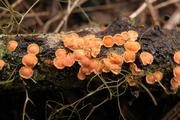
Adolf Ceska |
Byssomerulius corium (Pers.) Parmasto Ginns (synonym Meruliopsis corium (Pers.: Fr.) Ginns
| FRUITING BODY Spread out thinly over wood surface or bent outwards from surface to form a shelf-like cap], often confluent or shingled; individuals generally about 4cm by 2cm but sometimes double that, about 0.5-1 mm thick; the main part of the exposed surface "merulioid", gathered into folds that form pits between them, the folds up to a millimeter deep and less than a millimeter wide, often with small warty projections; consistency waxy, colored pale orange varying to yellow, yellow-brown, fawn, or red-orange; margin up to about 2mm wide, tomentose to cottony, whitish or rarely pinkish tan, the extreme edge fringed; where the fruitbody bends out to form a shelf-like cap, the cap projecting up to about 2 cm from the wood, firm, whitish, weakly zoned, appearing hairy or matted. FRUITING on bark and wood of hardwoods (rarely on conifers), especially on twigs and branches up to 3cm in diameter, mainly late summer and in fall. MICROSTRUCTURES basidiospores 4-7(8.5) x 2-3.5 nm, oblong to oval, smooth, colorless, inamyloid; cystidia lacking; hyphal system monomitic, clamp connections rather common. REMARKS According to Ginns(1976), Byssomerulius ambiguus grows primarily on conifers, and has a shiny, violaceous-brown to dark purple-black spore-bearing surface; Byssomerulius albostramineus and Gloeoporus taxicola may be violaceous or dark purple, and have small, allantoid or basally bent spores. ILLUSTRATIONS Breitenbach & Kränzlin.
| Byssomerulius corium
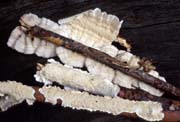
Steve Trudell
Byssomerulius corium surface
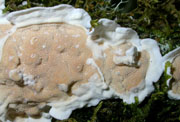
John Davis |
Chondrostereum purpureum (Pers.: Fr.) Pouzar silver leaf fungus
| FRUITBODY leathery fruitbodies growing flat on wood, or bent out to form overlapping caps projecting up to 4 cm, sometimes in masses 3-50 cm long, caps sometimes crimped or lobed, the upper surface light yellowish brown to light cinnamon brown or grayish, indistinctly zoned, often wrinkled or tuberculate (bumpy), may be hairy; spore-bearing surface (outer surface or underside of caps) light dingy purple to dark vinaceous buff, smooth to minutely powdery; margin distinct or slightly fringed. FRUITING on sticks, stems, stumps, branches or trunks of hardwoods, rarely conifers, associated with a white rot; infected trees such as fruit trees develop a leaf change called "silver leaf" disease, ultimately growth kills branches or the entire tree. MICROCHARACTERS spores 6.5-8 x 2.5-3.5 um, elliptic to cylindric, smooth, inamyloid, colorless; basidia 4-spored; sparse fusiform cystidia; monomitic, with clamp connections. ILLUSTRATIONS Breitenbach & Kränzlin, Lincoff (1995), Lincoff (1981)
| Chondrostereum purpureum
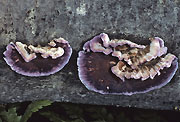
Kit Scates Barnhart |
Coniophora puteana (Schumach.: Fr.) P. Karst. wet-rot
| FRUITBODY growing flat on wood, starting as small rounded spots, then forming patches up to several decimeters across, up to 1 mm thick, attached tightly, consistency soft-membranous, fibrous; cream-colored when young, then yellow-brown to dark brown, smooth to tuberculate (bumpy) or verrucose (warty), paler toward margin, margin finely fringed. FRUITING destroys boards and timbers in buildings, especially in wet areas, causes discoloration and cracking; grows on dead conifer wood and hardwood, more rarely a wound parasite on living trees, causes a brown cubical rot. MICROCHARACTERS spores 10-13 x 7-8 um, ovoid, smooth, inamyloid, cyanophilic, light brown, thick-walled; basidia 4-spored; no cystidia; monomitic, without clamp connections. REMARKS ‘puteana’ means 'of wells'; another recognizable destroyer of wood in buildings is Serpula lacrymans but it is not very common in the Pacific Northwest. ILLUSTRATIONS Breitenbach & Kränzlin, Lincoff (1995)
| Coniophora puteana
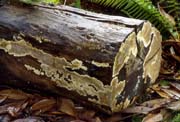
Steve Trudell |
Hymenochaete rubiginosa (Dicks.: Fr.) Lév.
FRUITBODY distinct caps projecting out from a flat layer on wood, usually fusing together in rows and imbricate (shingled), usually forming rather large patches up to several decimeters across; leathery-tough consistency; individual caps 1-4 cm across and projecting 1-4 cm from the wood, wavy, up to 1.2 mm thick, upper surface dark red-brown to ocher brown then blackish, concentrically grooved and zonate, finely tomentose to bald; cap margin sharp and somewhat lighter in color, wavy and scalloped, sometimes lobed; attachment may be extended and stem-like; flat part and underside of caps (spore-bearing surface) red-brown to orange-brown when fresh, sometimes with a lilac tint, then dark brown to gray-brown (brighter toward marginal zone), surface of spore-bearing area smooth or tuberculate (bumpy), either not cracked or deeply and scantily cracked when old. FRUITING on lower side of dead, barkless wood of Quercus (oak) and other hardwoods, associated with a white rot. MICROCHARACTERS spores 4.5-6 x 2.5-3 um, elliptic, smooth, inamyloid, colorless; basidia 4-spored; cystidia none, but narrow hyphidia present; setae numerous, 40-80 x 5-10 um, awl-shaped, dark brown, thick-walled; monomitic, septa without clamp connections. REMARKS ‘rubiginosa’ means 'rusty'; under 10x hand lens bristle-like setae visible on spore-bearing surface; tissue blackens in KOH; Pseudoochaete tabacina is never red-brown and has 1) consistency soft-leathery, when dry brittle, (whereas H. rubiginosa is leathery-tough, drying woody-hard), 2) cap surface radially fibrillose, hairy, bald when very old, (whereas H. rubiginosa has cap velvety but soon bald), 3) spore-bearing outer surface densely cracked, (whereas H. rubiginosa has surface either not cracked or deeply scantily creviced when old), 4) setal hyphae usually present but scattered, 120-250 um long, in addition to its setae, (whereas H. rubiginosa has setae but no setal hyphae). ILLUSTRATIONS Breitenbach & Kränzlin.
Hymenochaetopsis tabacina S.H. He & Jiao Yang (synonyms Hymenochaete tabacina, Hymenochaetopsis tabacina)
| FRUITBODY flat layer on wood, forming patches up to several decimeters across, initially as circular disks that become confluent, up to 0.6 mm thick; consistency membranous-leathery drying brittle; may have imbricate (shingled) caps projecting outward up to 1.5 cm; when caps present, they are wavy, upper surface rust brown then gray-brown or dark brown, concentrically zoned, radiately fibrillose and silky, bald when old; flat part and underside of caps (spore-bearing surface) yellowish brown to rust brown, sometimes with slight rosy tint (but not lilac tint), coffee brown when dry, flat part and underside of caps (spore-bearing area) dull, finely tomentose, often with concentric undulations, irregularly tuberculate (bumpy) or verrucose (warty), with fine radial cracks when dry; margin of spore-bearing area undulating, distinctly lifted, scalloped, golden when young, later colored as cap surface, edge of marginal area fibrillose or abrupt. FRUITING grows on mare than 150 species of trees and shrubs in North America, hardwoods more commonly than conifers, on bark or barkless twigs, branches, and trunks, the trees dead or standing. MICROCHARACTERS most fruitbodies studied are without basidia and spores, but recognizable due to presence of tomentum, cortex, setae, and setal hyphae in the context, although the setal hyphae are sometimes quite rare, spores 4.5-7 x 1.2-2.2 um, cylindric, slightly allantoid (curved sausage-shaped), smooth, inamyloid, colorless; basidia 4-spored; cystidia none, hyphidia none; setae 60-90 x 7-12 um, awl-shaped, dark brown, thick-walled, some finely incrusted toward tip; setal hyphae not numerous, 120-250 x 7-13 um, dark brown with thick walls; monomitic, septa without clamp connections. REMARKS ‘tabacina’ means 'pertaining to tobacco', probably referring to color; under 10x hand lens bristle-like setae visible on spore-bearing surface; tissue blackens in KOH; for differences from Hymenochaete rubiginosa, refer to that species. ILLUSTRATIONS Breitenbach & Kränzlin | Hymenochaetopsis tabacina
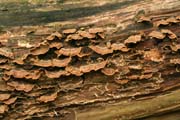
A and O Ceska |
Phlebia radiata Fr. radiating Phlebia
| FRUITBODY 1-4 cm wide growing flat on wood, circular at first but often confluent in sheets 10 cm or more across, up to 1 mm thick, attached firmly; the exposed spore-bearing surface reddish orange or pink, occasionally tan or pale orange or violet-gray, may be pruinose, often translucent, with narrow folds (ridges) interrupted, not forming pits but radiating, rarely branching, sometimes with convoluted pleats, also tuberculate (bumps) or verrucose (warty); hairy margin up to 3 mm wide and sometimes granulose, sometimes brighter or paler in color than the rest of the fruitbody; flesh waxy-soft, somewhat gelatinous, white to pallid. FRUITING on rotting wood of hardwoods and occasionally conifers, in fall, associated with a white rot. MICROCHARACTERS spores 3.5-7 x 1-2 um, cylindric, smooth, inamyloid, colorless; basidia 4-spored; inconspicuous cystidia may be present; monomitic, clamp connections present. ILLUSTRATIONS Phillips, Lincoff (1995), Breitenbach & Kränzlin. | Phlebia radiata
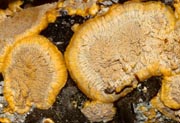
John Plischke |
Phlebia tremellosa (Schrad.: Fr.) Nakasone & Burds. (synonym Merulius tremellosus Schrad.)
| FRUITBODY growing flat or partly bent outward to form shelf-like caps, often imbricate (shingled), separable from the wood when fresh, often confluent, usually about 5 cm x 3 cm (but up to 25 cm x 10 cm), and 0.5 cm thick; if present caps projecting up to 5 cm, soft and cartilaginous, the upper surface white to pallid, tomentose to hirsute, not zoned or only slightly zoned; spore-bearing outer surface translucent, waxy, soft, gelatinous, elastic, when young or fresh pale orange-yellow to deep orange-red, usually blood red when older or dried, the folds narrow, up to 1.5 mm deep, radiating, branching, pleated in network pattern (merulioid) with radial folds dominating, occasionally forming long, nearly rectangular pits, 1 or 2 per millimeter; margin of flat part up to 2 mm wide, waxy, fringed, pale yellow to orange-red, occasionally darker; flesh soft, gelatinous, white to pallid. FRUITING on hardwood and less often conifer wood, associated with a white rot, common in fall. MICROCHARACTERS spores 3.5-4.5 x 1-1.5(2) um, cylindric, smooth, inamyloid, colorless, often with two droplets; basidia 4-spored, new basidia arise from a clamp connection at the base of the basidium; cystidia not present, but often there are thin-walled hyphae in the hymenium, projecting 20-30 um, often encrusted; monomitic, with clamp connections. REMARKS the somewhat similar Byssomerulius corium lacks clamp connections; Serpula species have dark spores. ILLUSTRATIONS (all as Merulius tremellosus) Breitenbach & Kränzlin, Lincoff (1981), Lincoff (1995), McKnight | Phlebia tremellosa
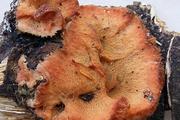
Bryce Kendrick |
cespitose - growing in tufts or close clusters from a common base, but not grown together
corticioid - as used by Ginns (1993) includes resupinate taxa with smooth, rough, or toothed spore-bearing surfaces but not resupinate polypores (refers to a general resemblance that certain typically spread out, thin fruitbodies have to bark); a term that covers many of the same fruitbodies as the "crust fungi"
hymenial - refers to the hymenium, the spore bearing surface, which faces outward when the corticioid fungus grows flat on the wood, or covers the underside of corticioid caps when they form
hyphidium (plural hyphidia) - a modified terminal hypha in the hymenium
pseudoacanthohyphidium (plural pseudoacanthohyphidia) - thin-walled hymenial elements that bear a few (2-5, rarely up to 10) apical projections; Stereum ostrea, Stereum rugosum, and Stereum sanguinolentum are members of the subgenus Aculeatostereum which have pseudoacanthohyphidia: (also known as pseudoacanthophyses, aculeate-tipped basidioles, acanthocystidia, and acanthohyphidia, by different authors, the last term also used for acanthophyses - with projections throughout their length - that occur in subgenus Acanthostereum not found in North America), (Chamuris(1985b))
pseudocystidium (plural pseudocystidia) - sterile structure that arises deep to the subhymenium and protrudes into the hymenium, true cystidia being directly associated with the hymenium and having their origin in the subhymenium; cystidium derived from a conducting element, filamentous to fusoid, oily contents, embedded or not projecting; in practice the differentiation between the cystidia and pseudocystidia is sometimes difficult and different authors may refer to the same structure as a cystidium or a pseudocystidium
lignicolous - living on wood
mycorrhizal - having particular symbiotic relationship with the roots of a seed plant, the rootlets of the plant being covered or permeated by the mycelium of the fungus
resupinate - lying flat on what fungus is growing on, without a stem or well-formed cap, with the gills or pores facing outward
tuberculate - with low bumps, larger than what would be considered warts
REFERENCES
- Allen, E.A. D.J. Morrison, G.W. Wallis. 1996. Common Tree Diseases in Britiish Columbia. National Resources Canada Canadian Forest Service.
- Arora, David. 1986 Mushrooms Demystified Second Edition. Ten Speed Press, Berkeley.
- Breitenbach, J., Kränzlin, F. 1986. Fungi of Switzerland Volume 2 Non-gilled Fungi. Edition Mykologia Lucerne.
- Burt, E.A. 1920. The Thelephoraceae of North America XII. Stereum. Ann. Missouri Bot. Gard. 7: 81-248.
- Burt, E.A. 1926. The Thelephoraceae of North America XV. Corticium. Ann. Missouri Bot. Gard. 13:173-358.
- Eriksson, J., L. Ryvarden. The Corticiaceae of North Europe. Volume 2. 60-286. 1973. Volume 3. 287-546. 1975. Volume 4. 547-886. 1976. Fungiflora, Oslo.
- Eriksson, J., K. Hjortstam & L. Ryvarden. The Corticiaceae of North Europe. Volume 5. 887-1047. 1978. Volume 6. 1048-1276. 1981. Volume 7. 1279-1449. 1984. Fungiflora, Oslo.
- Gibson, Ian, E. Gibson, B. Kendrick. September 2006. MatchMaker: Mushrooms of the Pacific Northwest. Compact Disc Version 1.21.
- Ginns, James. 1976. Merulius.: s.s. and s.l., taxonomic and identification of species. Can. J. Bot. 54: 100-167.
- Ginns, J. 1982. The wood-inhabiting fungus, Aleurodiscus dendroideus sp. nov., and the distinctions between A. grantii and A. amorphus. Canad. Field-Naturalist 96: 131-148.
- Ginns, James, M.N.L. Lefebvre. 1993. Lignicolous Corticioid Fungi (Basidiomycota) of North America Systematics, Distribution, and Ecology. The Mycological Society of America Mycologia Memoir No. 19. American Phytopathological Society Press. St. Paul, Minnesota.
- Ginns, James 1998. Genera of the North American Corticiaceae sensu lato. Mycologia 90(1): 1-35.
- Jülich, W., J.A. Stalpers 1980. The Resupinate Non-poroid Aphyllophorales of the Temperate Northern Hemisphere. North-Holland Publishing Company, Amsterdam, Oxford, New York.
- Lincoff, Gary. 1981. Simon and Shuster’s Guide to Mushrooms. Simon & Shuster, New York.
- Lincoff, Gary. 1995. National Audubon Society Field Guide to North American Mushrooms. Knopf, New York.
- McKnight, Kent H., McKnight, Vera B. 1987. A Field Guide to Mushrooms of North America. Peterson Field Guide Series. Houghton Mifflin, New York.
- Parmasto, Erast. 2001. Hymenochaetoid fungi (Basidiomycota) of North America. Mycotaxon 79: 107-176.
- Phillips, Roger. 1991. Mushrooms of North America. Little, Brown, & Co., Boston.
| ALEURODISCUS Rabenh. ex J. Schroet. |
| A. grantii Lloyd |
| |
| BYSSOMERULIUS Parmasto |
| B. corium (Pers.) Parmasto |
| |
| CHONDROSTEREUM Pouzar |
| C. purpureum (Pers.: Fr.) Pouzar |
| |
| CONIOPHORA DC |
| C. puteana (Schumach.: Fr.) P. Karst. |
| |
| HYMENOCHAETE Lév. |
| H. rubiginosa (Dicks: Fr.) Lév. |
| H. tabacina (see Hymenochaetopsis tabacina) |
|
| |
| HYMENOCHAETOPSIS S.H. He & Jiao Yang |
| H. tabacina (Sowerby) S.H. He & Jiao Yang |
| |
| MERULIOPSIS Bondartsev |
| M. corium (see Byssomerulius corium) |
| |
| MERULIUS Fr. |
| M. corium (see Byssomerulius corium) |
| M. tremellosus (see Phlebia tremellosa) |
| |
| PHLEBIA Fr. |
| P. radiata Fr. |
| P. tremellosa (Schrad.: Fr.) Nakasone & Burds. Fr. |
- END -

